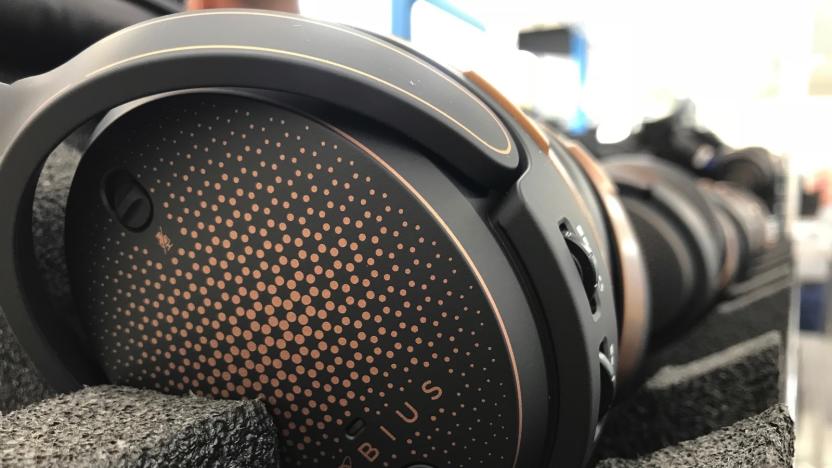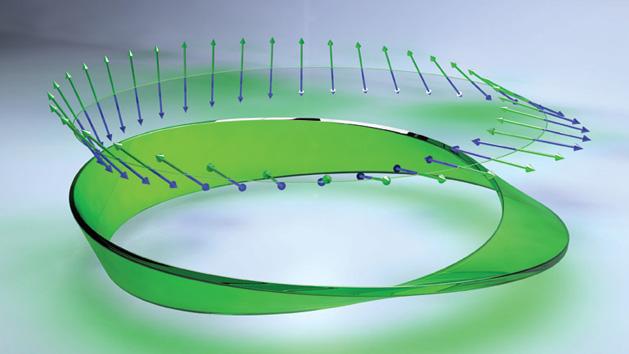mobius
Latest

Audeze’s ambitious Mobius is more than a gaming headset
Tucked inside an unassuming office park just south of LA, there's a modest factory where some of the best audiophile-grade headphones are assembled on a daily basis. Audeze has built its reputation on planar magnetic technology, drivers that produce a more natural sound thanks to better frequency response and super thin components. During my visit, the company was making its final preparations to launch Mobius, a gaming headset that packs in audiophile sound and 3D audio to create a more immersive experience, especially for gamers. The company's headquarters is just under an hour from LA in Santa Ana. Here, all of the Audeze headphones are assembled. The company even makes its planar magnetic drivers in the modest production facility, a setup that allows it to put together everything by hand, closely monitor quality control and maintain a steady R&D pace.

Scientists make a Mobius strip of laser light
Unless you count incidents in Star Trek episodes, Möbius strips don't really occur in nature -- you have to create that freaky one-sided shape yourself. However, a worldwide team of scientists may have produced the next best thing. They've created a Möbius strip of light by manipulating the polarization of the light's inherent electromagnetic field. The trick involves firing a highly focused laser beam through a liquid crystal lens to give it a very specific polarization. When the light scatters at the focal point with the help of a nanoparticle, that polarization creates tiny, twisted loops. While these strips were made in a lab, of course, the experiment shows that they're at least possible in nature.

Inhabitat's Week in Green: Möbius strip bridge, intelligent beehives and the SeaOrbiter
Each week our friends at Inhabitat recap the week's most interesting green developments and clean tech news for us -- it's the Week in Green. Apple's new headquarters is perhaps the most hotly anticipated building in the country, and the company just released a new set of images of the spaceship-shaped building. The new renderings provide a detailed look inside the ring-shaped building. Another ambitious proposal could be coming to life: The folks behind a futuristic marine-research vessel known as the SeaOrbiter just launched a crowdfunding campaign. Construction on the knife-shaped vessel is expected to begin next spring. On the gadget front, a pair of engineering students at Duke University has discovered a new way to charge smartphones with WiFi -- and they say the power-harvesting device is even more efficient than a USB charger.

E Ink launches Mobius flexible display for your next smartwatch
Although smartwatch makers have had access to e-paper for a while, there have been few such displays tailor-made for our wrists. E Ink is more than willing to fill that void with a new, watch-oriented version of its Mobius screen. The flexible, 1.73-inch panel won't floor anyone with its 320 x 240 grayscale picture, but it can be cut into timepiece-friendly shapes that take more abuse than a typical e-reader. More importantly for us end users, E Ink already has at least one hardware partner lined up: Sonostar is using the tiny Mobius for a smartwatch this summer, and the odds are that the company won't be alone.

Sony's 13.3-inch e-ink paper prototype shown off at education expo in Japan (video)
Earlier this week, we learned of Sony's plans for a 13.3-inch e-ink slate with stylus support pitched at students, and now Diginfo has caught up with the prototype device at the Educational IT Solutions Expo in Japan. The A4-sized tablet is said to be the first piece of hardware with an E Ink Mobius display that's flexible and light due to its new plastic construction. Co-developed by Sony and E Ink, the display only contributes 60g to the overall weight, which is apparently 50 percent lighter than similar screens built with glass. Sony says the software isn't quite as slick as it'd like it to be just yet, but nevertheless, you can check out people scrawling, annotating and highlighting on the prototype in the video below.

Canon C300 makes an appearance in Vincent Laforet's Mobius, find the short and behind the scenes right here (video)
A New York Times photojournalist turned Hollywood director, Vincent Laforet has become synonymous with DSLR video, after his short film Reverie helped catapult Canon's 5D Mark II into the world of digital filmmaking. And after playing such a significant role in launching that camera, we certainly weren't surprised to see Laforet make an appearance at today's Canon Cinema event, with his short film Mobius getting some time on the big screen. The film follows a photojournalist who stumbles upon a Cartel execution, but it also tells the story of Canon's tightly-veiled C300 cinema camera, which the company launched just moments ago. Laforet used a pre-production C300 (note the green tape button labels) to shoot Mobius in the Mojave Desert under a variety of harsh conditions, including powerful sunlight and near-darkness, in both extremely hot and chilly temperatures -- the camera appears to have performed extremely well, given both the remote shooting environment and tight production schedule. Canon has yet to reveal the C300's price tag, which we expect to far undercut the $120,000 Arri Alexa kit, but its sheer portability makes it a more appealing option for filmmakers -- especially those with limited time and other resources. Laforet was able to shoot his film with a very small crew, since the C300 can be operated by just one photographer. The director used the camera mounted on a tripod, tethered to a variety of helicopters, sitting on the road and even hand-held, like a camcorder or DSLR. Laforet shot with Canon's new FK30-300 telephoto cine zoom PL-mount lens, along with a variety of EOS mount lenses, and notes that the camera's form factor makes it even easier to shoot with than a DSLR like the 5D Mark II. Its cost -- somewhere in the range of $20,000 -- should also put it within reach of not only Hollywood cinematographers, but also television directors and even documentary filmmakers and news photojournalists. We won't see the C300 hit the market until late January 2012, so jump past the break for a sneak peak at Mobius to see Canon's new cinema flagship, along with a rather comprehensive behind-the-scenes video.%Gallery-138348%

MobiUS smartphone ultrasound hits the market two years too late for relevancy
Mobisante's MobiUS smartphone ultrasound system scored FDA approval back in February, a big step towards getting the product out the door. Now the brainchild of former Microsoft bigwig Dr. Sailesh Chutani is finally available to order, the only problem is that it's based around two-year-old tech. At the heart of the MobiUS system is a Toshiba TG01 (it of Windows Mobile 6.5 stock) a now hopelessly outdated handset. Still, the probe and phone together cost $7,495, just a tiny fraction of what traditional ultrasound systems cost. We're sure there are small clinics, especially in poor and remote parts of the world, that are already eyeing Dr. Chutani's solution and, if his company scores enough orders, he hopes to cut the price in half. Maybe they can put some of that money towards developing a system that works with smartphone platforms people actually use -- like Android and iOS. Check out the demo video after the break.

Mobisante's MobiUS smartphone ultrasound system secures FDA clearance, now needs to graduate from WinMo
The concept of a smartphone-based ultrasound imaging system is far from new, but Dr. Sailesh Chutani -- Mobisante's CEO and a former bigwig at Microsoft -- is bound and determined to take things beyond the drawing board. The aforesaid company has just landed what may in fact be the most important part of the production puzzle: 510(k) clearance from the US Food and Drug Administration. That's a major seal of approval, and pretty much allows the company to move forward with plans to get ultrasound technology into remote villages and rural hospitals where it's simply not feasible to purchase a $20,000+ system. Of course, there's still many years of work between now and then; the existing build only works on Toshiba's WinMo-based TG01 smartphone, and current estimates still put a $7,000 to $8,000 price tag on the whole MobiUS package. If it can reach critical mass, it's hoping to halve that asking price, and if things keep progressing, this may very well be the company that makes an ultrasound stethoscope a reality. Here's hoping this is just the firm's first celebration of many to come.

Eton Mobius, Soulra 2 and Road Torq hands-on
It seems that whole "solar panel" thing is working out pretty well for Eton, because the emergency radio company's got a slew of new products that charge with the sun's rays -- not just the angular Raptor, but also a brand-new wireless iPod boombox and an iPhone 4 external battery pack that use the very same tech. The Eton Mobius crams a monocrystal solar panel and an 1800mAh battery into an package just about 20mm thick, which Eton claims not will not only doubles the iPhone 4's battery life, but lets it run for nearly 20 minutes per hour of direct sunlight exposure. Meanwhile, the Soulra 2 boombox upgrades not only the power of its predecessor with a full eight speakers, but also the rate of charge, with a larger solar panel that lets it juice an internal 2000mAh pack in five hours, and pump out jams for up to eight. Both felt like pretty early prototypes when we gave them a heft, but the Soulra 2 gets fairly loud -- enough to hear music over the din of the CES floor, at least. It's also a heavy one, but comes with a carrying strap and handle. If you're bound and determined to have a hand crank on your emergency tool, though, you might want to give Eton's American Red Cross devices a look -- particularly this Road Torq stand-up beacon designed for car troubles. Flip out the combination flashlight / and red LED signal flare, pull out three reflector feet, and it stands up providing fifteen minutes of light for each minute you crank. PR after the break. %Gallery-112572%

Video: Sharp's Mebius LCD trackpad
Akihabara News was on-site for the unveiling of Sharp's Mebius netbook with combo LCD display and trackpad. Fortunately, they did the world a favor and snagged video (posted after the break) of the 854 x 480 pixel LCD in action. Sure, the icons and apps demonstrated are all a bit lame but the idea of repurposing that 4-inch space for a dual-purpose trackpad and secondary display / widget panel is killer. This friends, this is the future.

Sharp's Mebius PC-NJ70A packs LCD trackpad for the whiz-bang crowd
And you thought Apple's button-less "glass trackpad" was hot stuff. Sharp has just let loose details on its thoroughly Japanese Mebius PC-NJ70A, which sadly packs an exceptionally boring list of internal components but manages to stay interesting with a decidedly unorthodox trackpad. As you can see in the image above, Sharp has actually tossed an 854 x 480 resolution LCD right onto the palm rest, which automatically adjusts brightness based on surrounding light and can likely act as a secondary display for things like adjusting an equalizer with your digits. Beyond that, the netbook is downright drab, sporting just a 10.1-inch display (1,024 x 600), 1.6GHz Atom N270 processor, 1GB of RAM, a 160GB HDD, three USB 2.0 ports, Ethernet, WiFi, Bluetooth 2.1+EDR and a multicard reader. There's no set price as of yet, but word on the street puts it right around ¥80,000 ($817). Glamor shot after the break.

Sharp intros AMD-powered Mebius FW laptops
At first glance, Sharp's blindingly white PC-FW50X reminds us a lot of the PC-CW50T, but thankfully, the innards have improved somewhat since last summer. Packed within the aforesaid machine (¥150,000; $1,467) is a 15.4-inch WXGA (1,280 x 800) panel, 2GHz Mobile Sempron 3600+ processor, 2GB of RAM, a 120GB hard drive, dual-layer DVD burner, PCMCIA slot, four USB 2.0 ports and a 4-pin FireWire connector for good measure. Additionally, you'll find 802.11b/g WiFi, Ethernet, a multicard reader, VGA output and a rechargeable Li-ion. Those fond of darker hues can opt for the PC-FW70X (shown after the jump), which looks to pack a 1.9GHz Turion 64 X2 TL-58 CPU, start at ¥165,000 ($1,613) and ship right alongside its brother in late April.[Via Impress]

Mobius MKII speakers promise big sound, bigger price
Those who want their speakers to make as much of a statement with their looks as with their sound may want to keep an eye out for these new Mobius MKII behemoths, which promise a full 360 degrees of sound at reference-level quality. Measuring 38-inches tall, the speakers boast three drivers in the 8-inch bipolar array that sits up top, along with a custom made, front firing subwoofer that provides a frequency response down to 20Hz.. Just as importantly (to some), the speakers will also be available in a range of high-quality metallic or piano finishes, although not before the spring of 2008, which is when they're expected to make their debut. While there's no word on an exact price just yet, Audio Junkies says they should retail for somewhere in the neighborhood of $10,000 to $15,000.






